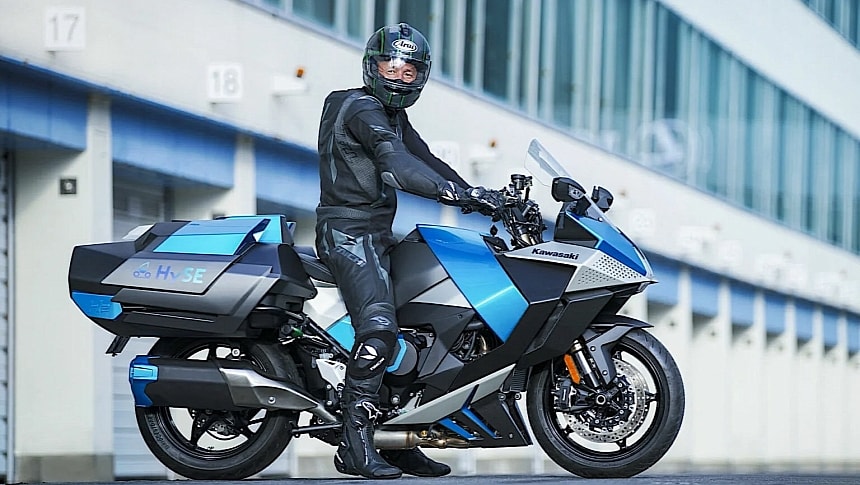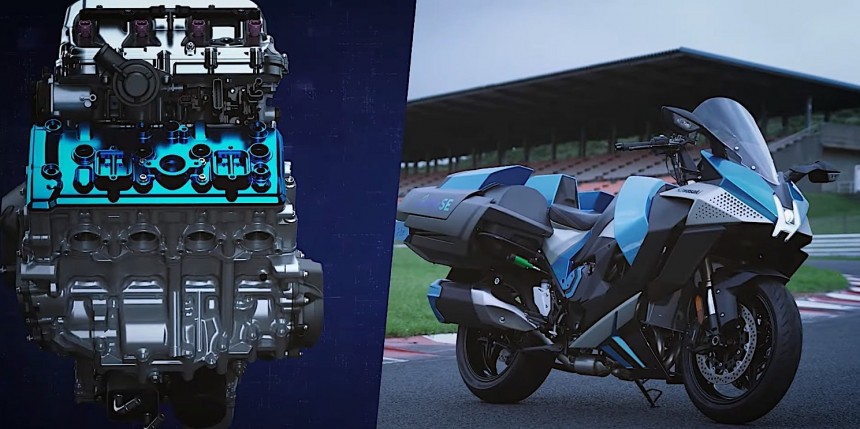Alternative means of propulsion for motorcycles are always in the works, but their success and adoption rates are, for one reason or another, much lower than when it comes to four-wheeled vehicles. Just look at how many electric bikes there are compared to electric cars, or the non-existent breed of hydrogen-powered bikes. Ok, maybe not non-existent, as Japanese bike maker Kawasaki just announced a world first concerning exactly such a thing.
You all know the good-old Ninja breed of motorcycles. One of its representatives, the H2, takes point in this story simply because it formed the basis for a new kind of bike - the engine that powers it has been modified by Kawasaki to burn hydrogen instead of regular fuel, and the ride just performed the world's first public demonstration run at the hands of a mass-production motorcycle maker.
Kawasaki started working on this project, somewhat behind closed doors, in March last year, and as soon as we stepped into the new year, it started conducting test runs of the two-wheeler. On July 20, at the Suzuka Circuit in Japan, it made short work of the hydrogen-powered bike in front of the public and cameras.
The bike you're looking at is not a Ninja true and true, as it has been altered quite a bit. The chassis of one such rides was modified to be able to hold hydrogen fuel canisters and a hydrogen fuel supply system. Then, the engine that sits in the frame, originally a supercharged 998cc in-line four, was tempered with so that it is now able to accept direct hydrogen injection into its cylinders instead of regular fuel injection.
The conversion was not particularly tricky to pull off, as hydrogen engines are still internal combustion engines, and they work in the same fashion: they are fed air and hydrogen, the two are mixed, ignited, and finally combusted.
Kawasaki did not go as far as providing us with the performance numbers of the modified engine, but you can get a sense of what it might feel like by having a look at the short video of the Suzuka run, posted below this text.
How does it feel? Well, according to Satoaki Ichi, the project's head, we're talking about a very gentle engine that kind of feels like… a humidifier. The analogy references one of the most notable manifestations of a hydrogen engine: the fact that the only byproduct of hydrogen being burned is water, which is shot out of the exhaust at the back in the form of mist.
Although a look cleaner that its gasoline-powered ICE counterparts, the hydrogen Ninja is not 100 percent green. That's because there is some CO2 generated by the burning of a small amount of engine oil, needed to keep all the moving parts operating smoothtly.
I must say, hearing the powerplant running in the very few instances the video allows us this is not particularly impressive. There is no roar, no scream, no bang, just a sort of docile hum I'm more used to hearing from some sort of home appliance.
But that's probably something that could easily be solved with the proper exhaust pipes, should Kawasaki ever realize its dream to mass produce the hydrogen-powered Ninja. For now, the project is just barely in the testing stages, and the "time of commercial availability may vary depending on the hydrogen fuel supply infrastructure and the status of legal regulations in each country."
When it gets here in production form (Kawasaki estimates we should have it on our roads sometime by the end of the decade), the Japanese dare to promise a hydrogen engine fitted on a motorcycle makes all the rumble and pulsating sensation riders enjoy as soon as they twist the throttle.
The bike is a project being run as part of the Hydrogen Small Mobility and Engine Technology (HySE) program announced by the bike maker in the fall of 2023. Kawasaki is not alone in this, as it is accompanied by all the other major Japanese bike makers (Suzuki, Honda, Yamaha), but also by carmaker Toyota.
The research conducted as part of HySE is meant to inform not only a hydrogen-powered motorcycle but also cars and all sorts of other small mobility vehicles. It also targets the creation of the required additional technologies, including filling and supply systems.
To date, however, the hydrogen Ninja is the first and only tangible result stemming from this. And that's a bit of a shame, considering the fact that hydrogen emits zero harmful emissions, just like battery-powered cars, but it is overall greener to make and distribute. Perhaps more importantly than anything for everyday drivers and riders, it doesn't take forever to fill the tank.
Sadly, because the automotive industry decided to go down the battery road, no one really invested in setting up the required hydrogen infrastructure, so for the same everyday users, a vehicle powered this way is presently a much bigger inconvenience than an EV.
Kawasaki started working on this project, somewhat behind closed doors, in March last year, and as soon as we stepped into the new year, it started conducting test runs of the two-wheeler. On July 20, at the Suzuka Circuit in Japan, it made short work of the hydrogen-powered bike in front of the public and cameras.
The bike you're looking at is not a Ninja true and true, as it has been altered quite a bit. The chassis of one such rides was modified to be able to hold hydrogen fuel canisters and a hydrogen fuel supply system. Then, the engine that sits in the frame, originally a supercharged 998cc in-line four, was tempered with so that it is now able to accept direct hydrogen injection into its cylinders instead of regular fuel injection.
The conversion was not particularly tricky to pull off, as hydrogen engines are still internal combustion engines, and they work in the same fashion: they are fed air and hydrogen, the two are mixed, ignited, and finally combusted.
Kawasaki did not go as far as providing us with the performance numbers of the modified engine, but you can get a sense of what it might feel like by having a look at the short video of the Suzuka run, posted below this text.
Although a look cleaner that its gasoline-powered ICE counterparts, the hydrogen Ninja is not 100 percent green. That's because there is some CO2 generated by the burning of a small amount of engine oil, needed to keep all the moving parts operating smoothtly.
I must say, hearing the powerplant running in the very few instances the video allows us this is not particularly impressive. There is no roar, no scream, no bang, just a sort of docile hum I'm more used to hearing from some sort of home appliance.
But that's probably something that could easily be solved with the proper exhaust pipes, should Kawasaki ever realize its dream to mass produce the hydrogen-powered Ninja. For now, the project is just barely in the testing stages, and the "time of commercial availability may vary depending on the hydrogen fuel supply infrastructure and the status of legal regulations in each country."
When it gets here in production form (Kawasaki estimates we should have it on our roads sometime by the end of the decade), the Japanese dare to promise a hydrogen engine fitted on a motorcycle makes all the rumble and pulsating sensation riders enjoy as soon as they twist the throttle.
The bike is a project being run as part of the Hydrogen Small Mobility and Engine Technology (HySE) program announced by the bike maker in the fall of 2023. Kawasaki is not alone in this, as it is accompanied by all the other major Japanese bike makers (Suzuki, Honda, Yamaha), but also by carmaker Toyota.
To date, however, the hydrogen Ninja is the first and only tangible result stemming from this. And that's a bit of a shame, considering the fact that hydrogen emits zero harmful emissions, just like battery-powered cars, but it is overall greener to make and distribute. Perhaps more importantly than anything for everyday drivers and riders, it doesn't take forever to fill the tank.
Sadly, because the automotive industry decided to go down the battery road, no one really invested in setting up the required hydrogen infrastructure, so for the same everyday users, a vehicle powered this way is presently a much bigger inconvenience than an EV.















